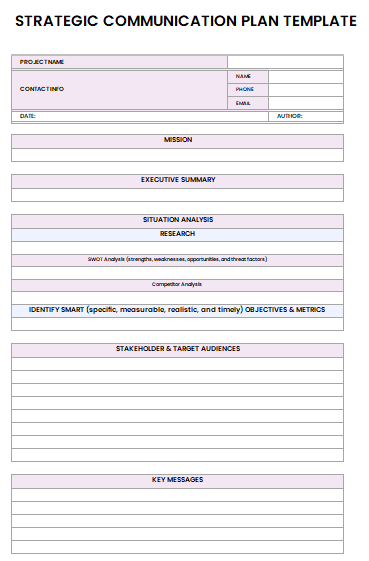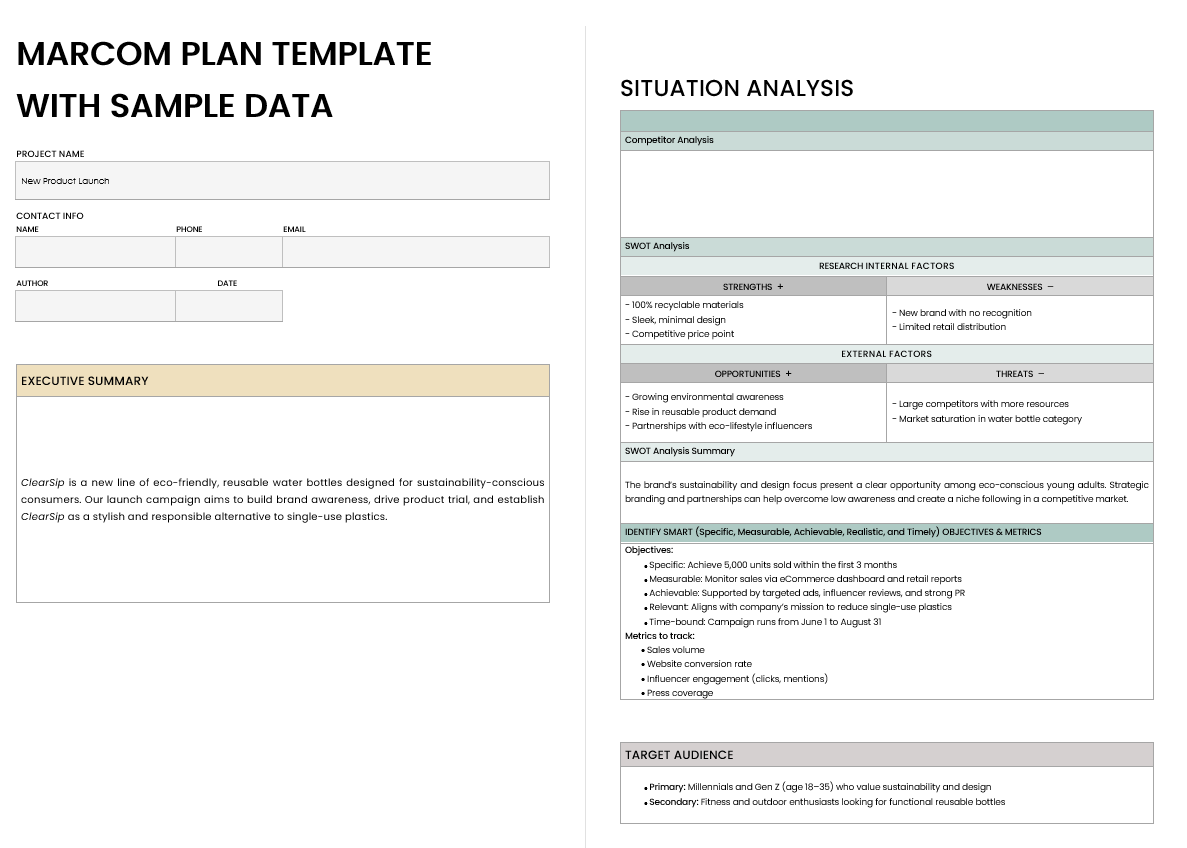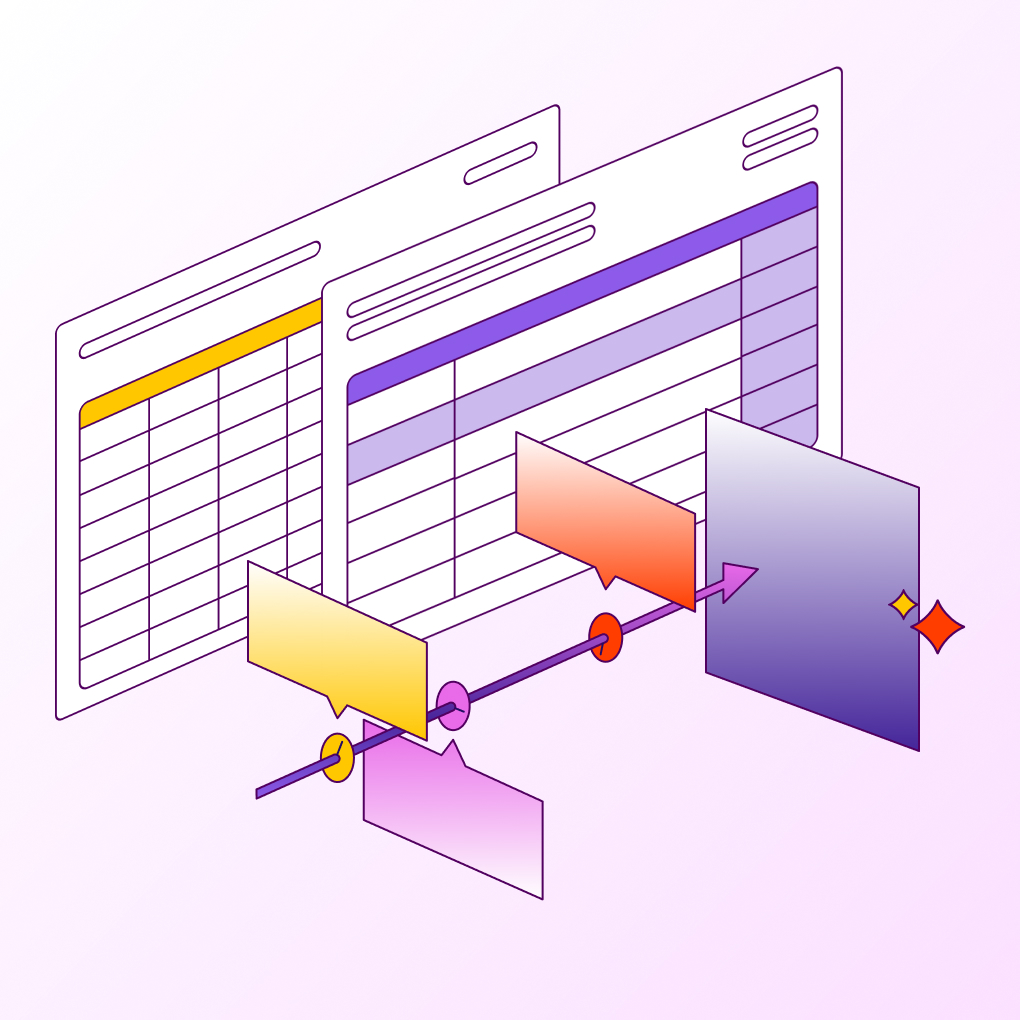Effective communication is essential in both work and personal life. Many people face challenges such as unclear messages, misunderstandings, and lack of engagement. A well-structured communication plan can address these issues by providing clarity and organization.
We help professionals, leaders, and teams share their ideas effectively. This ensures that messages are understood, reduces confusion, and enhances collaboration. A solid communication strategy supports any professional or leader when preparing for a presentation, writing an email, or having a difficult conversation.
The right strategy depends on the audience and the situation. It focuses on clear objectives, the clarity of the message, and the best methods for delivering information. By following simple steps, anyone can enhance their communication skills and achieve better results.
What Is a Communication Plan and Why Does It Matter?
A communication plan is a strategy for effectively sharing messages and information. It details what will be communicated, the audience, and the delivery method. A well-crafted plan ensures consistency, enhances engagement, and prevents important messages from being overlooked, providing clarity on who receives what information and when.
Communication Strategy vs. Communication Plan
A communication strategy outlines our goals and the methods we will use to reach them. A communication plan details how we will put this strategy into action. The strategy clarifies our objectives and addresses the questions of “why communicate” and “what needs to be done.” In simpler terms, it serves as a guide for what to communicate, when to do it, why it matters, and who the target audience is, in this case, specific groups within the Indian population. Together, these elements ensure that our messages are clear and well-structured.
Common Use Cases in Projects, Teams, and Marketing
A communication plan helps keep everyone involved in a project informed and on the same page. When team members miss important updates, it can cause delays in the project.
Teams work better together when everyone understands their roles. Leaders share goals, provide helpful feedback, and communicate important company information clearly.
In marketing, a communication planner ensures that messages are consistent across ads, emails, and social media. This consistency helps brands build trust with their customers.
A solid communication plan is valuable in any situation where clear messages are essential. It organizes scattered conversations into coherent communications.
Key Components of an Effective Communication Plan
A solid communication plan ensures that your message is clear, consistent, and impactful. It helps you deliver project messages to the right audience at the right time. Communication plans do not need to be overly formal or complicated. The most effective plans include an understanding of the audience, clear goals, and measurable outcomes. When combined, these elements improve the overall effectiveness of your communication.
Audience Segmentation
Not everyone requires the same information or prefers to receive it in the same way. A strong communication plan starts by categorizing the audience. Staff, supervisors, customers, and partners each have unique needs. Understanding these differences leads to more effective communication. For example, technical teams need detailed updates, while executives prefer concise summaries. By targeting your message, you ensure that the right information reaches the right audience.
Goals and Objectives
Every communication plan should clearly state its goals. These goals might include increasing awareness, boosting engagement, or minimizing confusion. Having clear objectives helps keep efforts on track. Instead of using vague phrases like “improve communication,” it is more effective to set specific targets, such as “reduce email response time by 20%.” A well-organized communication plan consistently connects messages to these objectives.
Core Messaging and Tone
The message should be clear and consistent. A well-structured communication plan outlines the main points and the appropriate tone. Formal reports should have a professional style, while team updates can be more casual. The tone must fit the audience and the purpose. For instance, a crisis update needs a serious tone, while a company milestone can be celebrated with a more upbeat tone. Keeping messages aligned helps avoid confusion.
Channels and Tactics
Selecting the appropriate method to share information is essential. A communication plan template should outline the best channels for each audience. For formal announcements, email is effective, while instant messaging is ideal for quick team updates. Social media can engage customers, and internal portals help keep employees informed. The format should match the message; complex topics may require video presentations or in-person meetings. Using the wrong channels in a communication plan can lead to messages being overlooked.
Frequency and Timing
Sending too many updates can overwhelm people, while too few can leave them feeling uninformed. A well-structured communication plan establishes a clear schedule. Weekly reports are effective for ongoing projects, but daily check-ins are essential for fast-paced tasks. Timing is also important; sending emails late at night may result in them being overlooked. The most effective plans strike a balance between providing regular updates and preventing information overload.
Roles and Responsibilities
A well-defined communication plan template outlines the responsibilities of each team member. One person might write the messages, another approves them, and a third shares them. When roles are not clearly defined, important steps can be overlooked. For instance, marketing teams may take care of customer updates, while HR handles internal announcements. Understanding who is responsible for each task helps avoid confusion and delays.
Measurement and KPIs
A plan that lacks tracking is merely guesswork. A thorough communication plan outline should include methods to measure success. Metrics such as open rates, engagement levels, and feedback surveys indicate whether messages are effective. For instance, if the goal is to enhance team alignment, monitoring meeting attendance or response rates can provide valuable insights. Regular reviews help identify what is working well and what requires adjustment. By using data, you can transform a good plan into a great one.
A solid communication plan is not just a document; it serves as a guide for improving conversations. Whether you use a basic communication plan template or create a custom comms plan template, these elements help ensure that your messages are effective every time.
Types of Communication Plans
Different situations require different ways of communicating. While a communication planner may use similar basic elements, the focus shifts depending on the goal. Some plans help keep teams on the same page, while others deal with emergencies or promote products.
Selecting the right type of communication ensures that messages are appropriate for the situation. Whether you are using a communication strategy or a straightforward communication template, the structure can be adjusted to meet specific needs.
Internal Communication Plan
An internal communication plan helps keep employees informed and engaged. It includes updates from leadership, changes in policies, and progress made by teams. Many companies use a communication timeline template to organize regular updates, such as newsletters or meetings. The aim is to promote transparency and alignment throughout the organization. Without clear internal communication, employees might feel disconnected or overlook important information. A well-organized plan ensures that everyone is on the same page.
Marketing Communication Plan
This type of plan is designed to promote products or services to customers. A marketing communication (marcom) plan template typically includes advertising, social media, and email campaigns. The messaging emphasizes benefits and enhances brand awareness. Unlike internal plans, marketing communication focuses on external audiences. Consistency is crucial—every advertisement, post, or email should convey the same core message. A solid plan helps attract and keep customers while ensuring a unified brand voice.
Crisis Communication Plan
When issues come up, fast and clear communication is essential. A crisis plan explains how to handle emergencies, negative media coverage, or unexpected situations. It includes approved messages, designated spokespeople, and steps to manage the situation. Many companies use a communication strategy plan template to get ready for possible crises in advance. Without this plan, confusion can worsen the problems. Having a ready-to-use structure helps address issues calmly and professionally.
Change Management Communication Plan
Organizational changes, such as mergers or new policies, require thoughtful management. This plan outlines the reasons for the changes and their impact on individuals. By addressing concerns early, it helps reduce resistance. A free communication plan template can assist leaders in sharing updates gradually, allowing employees time to adapt. Providing clear and regular updates prevents rumors and maintains trust during transitions. A well-planned approach makes change smoother for everyone involved.
Project Communication Plan
Projects require coordination among teams, clients, and stakeholders. This plan outlines who needs updates, how often they should receive them, and in what format. A communication timeline template helps keep track of deadlines and meetings. Without it, team members may overlook important details or deadlines. Regular check-ins help ensure that projects progress smoothly. Whether you use a simple communication template or a more detailed strategy, the plan guarantees that nothing is overlooked.
Each type of communication plan serves a unique purpose, but they all aim for one thing—clear and effective messaging. A well-structured plan enhances communication, whether you are managing a crisis, launching a product, or guiding a team through changes. Templates like a communication strategy or a marketing communication plan provide a useful starting point for any situation.
How to Write Your Communication Plan (Step-by-Step)
Creating a communications plan can be straightforward. By using a structured approach, you can ensure your messages are clear, consistent, and efficient. Whether you choose a template in Word or design your own format, following these steps will help you build a solid foundation. Start by identifying any current gaps and finish by measuring your success.
Step 1 – Audit Current Communication Tools and Gaps
Before creating a new plan, take a moment to review what is already in place. Examine emails, meetings, and messaging apps to identify what is effective and what is not. Are employees missing important updates? Are customers unclear about product information? Recognizing these gaps will help you develop a more effective communication plan.
Additionally, assess whether current tools, such as newsletters or Slack channels, are being utilized properly. This step ensures that the new plan addresses existing issues rather than introducing unnecessary complications.
Step 2 – Identify Your Target Audiences
Not everyone requires the same information. A leadership team needs different updates compared to frontline staff. Similarly, customers require different messages than partners. A clear communication plan organizes audiences into groups and specifies what each group needs to know.
For instance, project teams may need technical details, while executives prefer high-level summaries. Identifying these groups early helps avoid sending irrelevant messages later. This approach ensures that the right people receive the right content.
Step 3 – Set SMART Goals
A plan without clear goals is merely guesswork. To create effective goals, use the SMART criteria: they should be specific, measurable, achievable, realistic, and time-bound. For example, a strong goal would be to reduce email response time to under two hours by the end of the third quarter, rather than just focusing on improving team communication.
Your communication plan template should connect every message to these objectives. Goals might include increasing engagement, speeding up decision-making, or reducing customer complaints. Having clear targets makes it easier to measure success later on.
Step 4 – Choose Communication Formats and Channels
The method of sharing information is just as important as the message itself. A communication plan should align the channel with the audience and the purpose. For quick team updates, Slack is often the best choice, while formal emails or meetings are more suitable for policy changes.
Visual learners tend to favor videos or infographics, while analytical audiences appreciate detailed reports. Using the wrong format can lead to messages being overlooked or misunderstood. This step ensures that each piece of content is delivered in the most effective way possible.
Step 5 – Assign Owners and Map Out a Timeline
A plan is effective only when someone is accountable for each task. A communication plan template in Word should clearly outline who is responsible for creating, approving, and sending each message. For instance, the marketing team may manage customer newsletters, while the HR department takes care of internal announcements.
Additionally, a timeline should establish deadlines for drafts, reviews, and distribution. Without defined roles and schedules, important steps can be overlooked. This approach helps avoid last-minute scrambles and ensures that communication remains consistent.
Step 6 – Track Performance and Adapt the Plan
Even the best plans need some changes. A communication plan should include ways to measure success, such as open rates, survey feedback, or meeting attendance. If emails are not being read, consider trying a different format or subject line.
If team members still have questions after a presentation, the messaging may need to be simplified. Regular check-ins can help identify what is working and what is not. This approach transforms a static document into a dynamic strategy that improves over time.
By following these steps, you can create a communication plan that is effective. Using a communication plan template also makes the process more thorough. This leads to clearer messages, increased engagement, and fewer misunderstandings. A well-planned approach saves everyone time and reduces frustration.
The key is to start simple and experiment with a few ideas, then make adjustments as needed. With practice, effective communication will become a competitive advantage rather than a daily challenge.
Communication Plan Templates & Formats
Developing a communication plan from the ground up can be time-consuming. Using pre-made templates can help streamline this process and ensure that important details are not overlooked. Whether you require a straightforward communication plan for short-term projects or a comprehensive plan for long-term objectives, selecting the appropriate format can simplify your planning efforts. These templates offer a clear structure, allowing you to concentrate on the content instead of the design.
Communication Plan Template (Editable Table Format)
A well-organized table format helps keep information clear. You can use rows to list different messages and columns to track important details such as the audience, channel, and owner. This style of communication strategy template allows you to view the entire plan at once. Tables are especially useful for teams that need to update their plans often. The structured layout reduces confusion and ensures that all communications remain consistent.
| Communication Type | Purpose | Audience | Frequency | Format/Channel | Owner/Responsible | Status/Notes |
| Project Kick-off Meeting | Align team on project goals & timeline | Project Team, Stakeholders | One-time | In-person / Video Call | Project Manager | Scheduled for [Insert Date] |
| Weekly Status Report | Update on progress, issues, milestones | Project Team, Sponsor | Weekly | Email / PDF Document | Team Lead | First report due [Insert Date] |
| Stakeholder Update | Inform stakeholders of high-level progress | Key Stakeholders | Bi-weekly | Presentation / Email | Communication Officer | Template approved |
| Risk Management Alert | Communicate risks & mitigation plans | Project Team | As needed | Email / Instant Messaging | Risk Manager | In use |
| Change Request Notification | Inform about changes in scope/timeline | Stakeholders, Team | As needed | Change Log / Email | Change Manager | Include in weekly briefings |
| Project Review Meeting | Review outcomes & lessons learned | Project Team, Sponsors | End of Project | Meeting (In-person/Virtual) | Project Manager | To be scheduled |
Communication Strategy Plan Template

For larger projects, a strategic communication plan template is essential for aligning messaging with business goals. These templates typically include sections for SWOT analysis, key messages, and evaluation metrics. They are designed to support long-term planning rather than focusing on individual projects. Companies utilize these templates to ensure that all communication efforts consistently support the same objectives over months or even years.
Marketing communication Plan Template for Product Launches

Marketing teams require specific tools, such as a marketing communications plan template. These tools are essential for managing product launches, campaigns, and customer engagement. They provide timelines for advertisements, social media activities, and public relations efforts. A sample marketing communications plan illustrates how to coordinate various channels for the best results. These templates assist marketing teams in staying organized while ensuring that their messaging remains consistent.
Using templates not only saves time but also enhances outcomes. Whether you opt for a simple communication plan template or a more detailed marketing communications plan template, having a ready-made structure guarantees that you address all important elements. The right format streamlines planning and makes execution more efficient.
Conclusion
A solid communication plan ensures that messages are clear and consistent. Regardless of the platform used, a well-thought-out strategy keeps all stakeholders informed and aligned. Using templates, like a basic communication plan template or a specialized marketing communication plan template, can save valuable time. Key steps include setting objectives, understanding your audience, choosing the right channels, and tracking results.
When used effectively, communication can be a powerful tool for engaging people. Start by creating a straightforward strategy and adapt it as needed. Better communication leads to more effective actions. Having a plan helps organize ideas for clearer communication.




